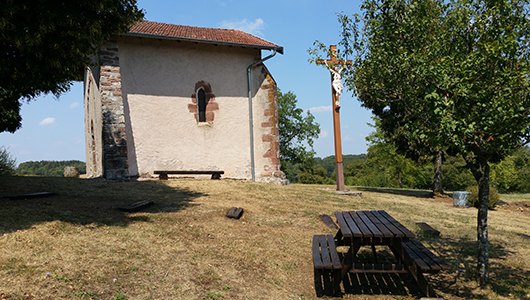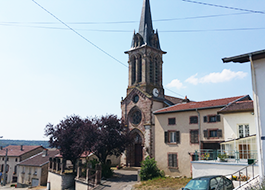Fontenoy-la-Joûte
Durée visite : 30 minutes
Moyen : Pédestre
Ancien territoire des gaulois Leuques, experts dans le lancer d’épieu, Fontenoy est attesté vers 1120. Un prieuré est fondé par l’abbé de Senones. Les échevins sont nommés conjointement par le comte de Blâmont et l’abbé de Senones. A la fin du XVIe siècle, une femme et trois bourgeois sont accusés de sorcellerie. Ils sont soumis à la question, c’est-à-dire torturés, puis brûlés vifs. En 1635, les horreurs de la guerre de Trente Ans atteignent Fontenoy. A cette époque, le terme de Joûte est accolé au nom du village. Ce n’est pas lié à des tournois chevaleresques, mais plus prosaïquement au patois lorrain jotte. Il signifie choux à cuisiner. Peut-être grâce à ces vitamines, de 36 habitants en 1710, la population passe à 678 en 1840. Fontenoy-la-Joûte est un village du livre depuis 1996, il comporte une vingtaine de bouquineries. C’est le père Serge Bonnet qui est à l’origine de la manifestation dans cette commune.
Former territory of the Gallic Leuques, experts in spear throwing, Fontenoy is attested around 1120.
A priory was founded by the abbot of Senones. The aldermen are appointed jointly by the count de Blâmont and the abbot of Senones. At the end of the 16th century, a woman and three bourgeois were accused of witchcraft. They are subjected to the question, that is to say tortured, then burned alive. In 1635, the horrors of the Thirty Years’ War reached Fontenoy. At that time, the term Joûte was added to the name of the village. It is not linked to chivalrous tournaments, but more prosaically to the Lorraine patois jotte. It means cabbage to cook. Perhaps thanks to these vitamins, from 36 inhabitants in 1710, the population increases to 678 in 1840. Fontenoy-la-Joûte has been a village of books since 1996, it has about twenty booksellers. It is Father Serge Bonnet who is at the origin of the demonstration in this town.
Fontenoy, ehemaliges Gebiet der gallischen Leuques, Experten für Speerwerfen, ist um 1120 bezeugt. Ein Priorat wurde vom Abt von Senones gegründet. Die Stadträte werden gemeinsam vom Grafen von Blâmont und dem Abt von Senones ernannt. Ende des 16. Jahrhunderts wurden eine Frau und drei Bourgeois der Hexerei beschuldigt. Sie sind der Frage ausgesetzt, das heißt gefoltert und dann lebendig verbrannt. 1635 erreichten die Schrecken des Dreißigjährigen Krieges Fontenoy. Zu dieser Zeit wurde der Name Joûte zum Namen des Dorfes hinzugefügt. Es ist nicht mit ritterlichen Turnieren verbunden, sondern eher prosaisch mit dem lothringischen Patois Jotte. Es bedeutet Kohl zu kochen. Vielleicht steigt die Bevölkerung dank dieser Vitamine von 36 Einwohnern im Jahr 1710 auf 678 im Jahr 1840. Fontenoy-la-Joûte ist seit 1996 ein Buchdorf mit etwa zwanzig Buchhändlern. Es ist Pater Serge Bonnet, der den Ursprung der Demonstration in dieser Stadt darstellt.

D’azur à une clef d’or et une épée d’argent passées en sautoir, au chef cousu de gueules chargé d’un livre ouvert d’argent.
Fontenoy dépendait de l’abbaye Saint Pierre de Senones, qui porte une clef et une épée en sautoir ; Le chef chargé d’un livre ouvert indique que Fontenoy est un village du livre.
Azure with a golden key and a silver sword set in saltire, a chief sewn Gules charged with an open silver pound.
Fontenoy belonged to the Abbey of Saint Pierre de Senones, which carries a key and a saltire sword; The chief in charge of an open book indicates that Fontenoy is a village of books.
Azurblau mit einem goldenen Schlüssel und einem silbernen Schwert in Saltire, ein Häuptling, der Gules mit einem offenen Silberpfund aufgenäht hat.
Fontenoy gehörte zur Abtei von Saint Pierre de Senones, die einen Schlüssel und ein Saltire-Schwert trägt; Der Chef, der für ein offenes Buch verantwortlich ist, gibt an, dass Fontenoy ein Dorf der Bücher ist.
Les points de visites
.
Fontenoy doit son nom à l’abondance d’eau de la région. Cette jolie fontaine est semble-t-il un cousin du Manneken Pis. Le gamin vous annonce que son eau est bonne à boire.
Fontenoy owes its name to the region’s abundance of water. This pretty fountain is apparently a cousin of the Manneken Pis. The kid tells you that his water is safe to drink.
Fontenoy verdankt seinen Namen dem Wasserreichtum der Region. Dieser hübsche Brunnen ist anscheinend ein Cousin der Manneken Pis. Das Kind sagt dir, dass sein Wasser trinkbar ist.
.
.
L’église actuelle est édifiée entre 1864 et 1869. Elle succède à deux édifices sur le même emplacement. Elle s’inscrit dans le vaste mouvement de reconstruction d’églises rurales en Lorraine, dans la seconde moitié de XIXe siècle. Le manque de place et le peu d’intérêt artistique des bâtiments précédents sont les raisons principales de ces travaux. Auteur prolifique, on lui doit 60 églises et chapelles, l’architecte nancéien Léon Vautrin est retenu. Inspiré des thèses de Viollet-le-Duc. Un entrepreneur de Laronxe réalise les travaux ; leur montant est de 50266 francs. Les voûtes en briques creuses, dont la faible poussée autorise l’emploi de contreforts peu saillants, sont utilisées de même que des ancrages et tirants métalliques dans la maçonnerie. L’édifice est une nef à trois vaisseaux de cinq travées, avec une tour-porche. Cette conformité à un style rationaliste, déjà éprouvé par ailleurs, se retrouve dans l’élévation extérieure. A l’intérieur, l’ébéniste a fait une chaire gothique et la statuaire est étonnamment colorée.
Dans la rue Saint Pierre, un peu au dessus de l’église, une fontaine est au milieu de deux bassins, servant d’abreuvoir. Une statue est présente. Elle est plus pudique que celle que vous pouvez découvrir plus bas dans le village. Elle représente Saint-Pierre. Celui ci tient ses clés de la main droite et montre le ciel de l’autre. La clef d’argent libère du péché terrestre, la clef d’or ouvre les Portes du royaume des Cieux.
The current church was built between 1864 and 1869. It succeeds two buildings on the same site. It is part of the vast movement to rebuild rural churches in Lorraine, in the second half of the 19th century. The lack of space and the lack of artistic interest of the previous buildings are the main reasons for this work. A prolific author, we owe him 60 churches and chapels, the Nancy architect Léon Vautrin is selected. Inspired by the theses of Viollet-le-Duc. A contractor from Laronxe carries out the work; their amount is 50,266 francs. Hollow brick vaults, whose low thrust allows the use of slightly protruding buttresses, are used as well as metal anchors and tie rods in the masonry. The building is a nave with three aisles of five bays, with a tower-porch. This conformity to a rationalist style, already proven elsewhere, is found in the exterior elevation. Inside, the cabinetmaker has made a Gothic pulpit and the statuary is surprisingly colorful.
In the rue Saint Pierre, a little above the church, a fountain is in the middle of two basins, serving as a drinking trough. A statue is present. It is more modest than the one you can discover further down in the village. It represents Saint-Pierre. He holds his keys with his right hand and shows the sky with the other. The silver key frees from earthly sin, the golden key opens the Gates of the kingdom of Heaven.
Die heutige Kirche wurde zwischen 1864 und 1869 erbaut. Sie folgt zwei Gebäuden an derselben Stelle. Es ist Teil der großen Bewegung, in der zweiten Hälfte des 19. Jahrhunderts ländliche Kirchen in Lothringen wieder aufzubauen. Der Platzmangel und das mangelnde künstlerische Interesse der bisherigen Gebäude sind die Hauptgründe für diese Arbeit. Als produktiver Autor schulden wir ihm 60 Kirchen und Kapellen, der Nancy-Architekt Léon Vautrin wird ausgewählt. Inspiriert von den Thesen von Viollet-le-Duc. Ein Auftragnehmer aus Laronxe führt die Arbeiten aus; ihr Betrag beträgt 50.266 Franken. Im Mauerwerk werden hohle Ziegelgewölbe verwendet, deren geringer Schub die Verwendung leicht hervorstehender Strebepfeiler ermöglicht, sowie Metallanker und Zugstangen. Das Gebäude ist ein Kirchenschiff mit drei Gängen mit fünf Buchten und einer Veranda. Diese Konformität mit einem rationalistischen Stil, der bereits an anderer Stelle bewiesen wurde, findet sich in der Außenansicht. Im Inneren hat der Tischler eine gotische Kanzel gemacht und die Statue ist überraschend bunt.
In der Rue Saint Pierre, etwas oberhalb der Kirche, befindet sich in der Mitte zweier Becken ein Brunnen, der als Tränke dient. Eine Statue ist vorhanden. Es ist bescheidener als das, das Sie weiter unten im Dorf entdecken können. Es repräsentiert Saint-Pierre. Er hält seine Schlüssel mit der rechten Hand und zeigt mit der anderen den Himmel. Der silberne Schlüssel befreit von irdischer Sünde, der goldene Schlüssel öffnet die Tore des Himmelreichs.
.
La chapelle saint-Pierre est le chœur de l’ancienne église Saint-Pierre, attestée dès 1120 et reconstruite au XIIIe siècle.
Cet édifice rectangulaire, couvert d’une toiture à deux pans, est renforcé dans les angles par quatre contreforts.
On retrouve deux vestiges de cette époque : d’une part, le linteau trilobé au-dessus de la porte d’entrée gravé d’une croix pattée. Et d’autre part, dans le mur opposé à la porte, une petite ouverture quadrilobée.
Au-dessus de la porte, on remarque la trace d’un arc triomphal. Il assurait la transition entre le chœur, conservé, et la nef, détruite au XVIIe siècle.
L’église avait été modifiée au XVe siècle : réalisation de voûtes d’ogives, percement de la porte dans le mur occidental, qui a conservé sa ferronnerie d’époque, adjonction d’un lavabo et d’une armoire eucharistique.
A l’intérieur on distingue un autel et une statue de saint Pierre.
La chapelle a été restaurée en 2017. On peut voir à côté une croix monumentale et une statue du Sacré-Cœur-de-Jésus.
The Saint-Pierre chapel is the choir of the old Saint-Pierre church, attested from 1120 and rebuilt in the 13th century. This rectangular building, covered with a two-sided roof, is reinforced in the corners by four buttresses. There are two vestiges of this period: on the one hand, the trilobed lintel above the entrance door engraved with a cross pattée. And on the other hand, in the wall opposite the door, a small quadrilobed opening. Above the door, we notice the trace of a triumphal arch. It ensured the transition between the choir, preserved, and the nave, destroyed in the 17th century. The church had been modified in the 15th century: making ribbed vaults, piercing the door in the western wall, which has retained its period ironwork, adding a sink and a Eucharistic cabinet. Inside we can see an altar and a statue of Saint Peter. The chapel was restored in 2017. Next to it you can see a monumental cross and a statue of the Sacred Heart of Jesus.
Die Saint-Pierre-Kapelle ist der Chor der alten Saint-Pierre-Kirche, die ab 1120 bezeugt und im 13. Jahrhundert wieder aufgebaut wurde. Dieses rechteckige Gebäude, das mit einem zweiseitigen Dach bedeckt ist, ist in den Ecken durch vier Strebepfeiler verstärkt. Es gibt zwei Überreste dieser Zeit: Einerseits den dreilappigen Sturz über der Eingangstür, in den ein Kreuzmuster eingraviert ist. Und andererseits in der Wand gegenüber der Tür eine kleine viereckige Öffnung. Über der Tür bemerken wir die Spur eines Triumphbogens. Es stellte den Übergang zwischen dem erhaltenen Chor und dem im 17. Jahrhundert zerstörten Kirchenschiff sicher. Die Kirche wurde im 15. Jahrhundert umgebaut: Schaffung von Rippengewölben, Öffnung der Tür in der Westwand, die ihre alten Eisenarbeiten beibehalten hat, Hinzufügung eines Waschbeckens und eines eucharistischen Schranks. Im Inneren sehen wir einen Altar und eine Statue des Heiligen Petrus. Die Kapelle wurde 2017 restauriert. Daneben sehen Sie ein monumentales Kreuz und eine Statue des Heiligen Herzens Jesu.








